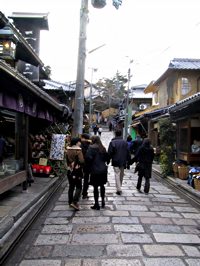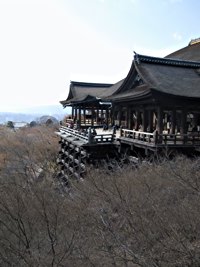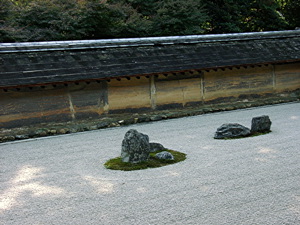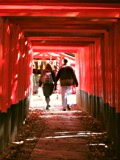
|
|||||||
|
|||||||
GENERAL NOTES
-
Make your reservations NOW! - You are going to Kyoto during the BIGGEST tourist season of the year... Cherry Blossom Season. It's also a time for wonderful weather and huge crowds. I really suggest planning your Kyoto time mid-week. It will be much easier for you to get around during the day - think a million times more crowded than Disneyland on the first weekend in summer. It is also a wonderful time to be in Kyoto so consider yourself lucky for having such fabulous timing.
-
If you're going to stay in Kyoto, I highly recommend going for something centrally located. The hotel I'm most familiar with is the Kyoto Co-op Inn. If you can't get a room, then you might try the Kyoto Traveler's Inn.
-
Bring US Dollar T/Cs and Carry cash - Hotels and Department stores often accept credit, but MOST small stores / temples / shrines DO NOT. Banks are usually open between 8 or 9 and 3pm on weekdays. They are usually closed on Sat / Sun and Holidays. ATMs close in Japan on holidays and in the evenings (from 7 or 8pm). There is an ATM on the top floor of Takashimaya Department Store that accepts ATM cards and is very handy. Most big banks (Sanwa, Sumitomo) will exchange your T/C with no problem, but some smaller branches may have a harder time. Just be sure to have your passport handy and choose the bigger buildings when possible. BTW / DO NOT buy yen T/C... only dollars.
-
Carry Toilet Paper - If you see people handing out free "tissues" on the street, grab them and keep them with you. Public rest rooms often DO NOT stock TP and it's up to you to BYO. You can usually buy some for some change outside the restroom. Hotels, Department Stores and (believe it or not) Gas Stations usually have very clean restrooms with TP and everything.
-
Carry hand towels - You can buy a small wash cloth or handkerchief to use for drying your hands in public restrooms. They rarely supply towels either.
-
Be prompt - Things close on time. Restaurants have a "last order" that is anywhere from 30 - 45 minutes BEFORE closing.
IN HIROSHIMA / MIYAJIMA
-
Places / Things to see:
-
Gempaku Dome Hiroshima Memorial Museum - You could spend a whole day here and get very depressed. It's a FABULOUS exhibit but a little bit hard to take after several hours. Instead, spend a half day and give yourself time to reflect on the experience during a picnic in Peace Park which surrounds the Museum.
-
Miyajima Island - Itsukushima Jinja (This temple is actually ON the water and has a beautiful large torii gate found on the cover of many guidebooks. I really recommend staying at the youth hostel and then taking the first ferry over to the island (around 6:30am). It's fantastic in the morning before the crowds arrive.
-
-
Places to stay:
-
Miyajima Youth Hostel
-
-
Things to eat:
-
Momiji Manju - Japanese bean and / or custard cakes in the shape of autumn leaves. VERY TASTY
-
Okonomiyaki - This is a pancake filled with veggies and meat that is a specialty of the area. I ask for it NIKU-NUKI because I'm vegetarian (Saishokushugi). If you want to go kosher, we can talk about what to ask for over the phone
-
IN KYOTO
PLACES TO GET INFORMATION:
-
International Center for map (near Keage, Ginkakuji Walking Tour)
-
Kyoto Station for Bus Maps (Kyoto Station)
KYOTO STATION - These are right within walking distance of the station (convenient but not as interesting as items below)
-
Nishi/Higashi Honganji - East and West Temple
-
Sanju Sangendo - Palace of 1000 Buddhas.
NEAR SANJO / DOWNTOWN - There are a number of very famous temples and shrines within walking distance (long walk or subway) from where you'll be staying. I will suggest my favorites - each has it's own charm.
SHIJO KAWARAMACHI - is downtown with all of it's bustling shops and pachinko parlors. DON'T MISS the Takashimaya Department Store Basement for the best choice of prepared foods (for a picnic) in town.
TERAMACHI - A playland of stores right near your hotel. Look for Nishiki doori (the largest covered market in Kyoto) - it's near Shijo and you may have to ask a few people to point you in the right direction but it will be worth it.
1. FIRST WALKING TOUR - KIYOMIZU DERA 
First walk east up Shijo-doori (4th Street) to the end and climb the steps at the entrance of Yasaka Jinja. After walking up through the shrine grounds, exit out the gate on your right. If you walk down the road straight ahead, you will pass some apartment buildings, and then you will see a small, dark entrance on the left that will take you to a very quiet cobblestone path. TAKE THIS PATH and it will lead you to Ninenzaka, Sannenzaka (famous old shopping quarters that is now a bit touristy) and ultimately to Kiyomizu-dera - One of the most famous temples in all of Japan. On your way up to Kiyomizu, you should sample the little triangle beancakes (yatsuhashi). There are several shops where you can sample these - the best is on your left very near the top of the street before you get to Kiyomizu-dera.
 Walk
up the steps to Kiyomizu-dera, pay, and enter the temple. The
wooden platform is very famous (there is a saying: "Do such-and-such
with the spirit of jumping from Kiyomizu-dera's platform"
though it sounds MUCH better in Japanese). Make
sure to visit the shrine behind the temple - it sells a large
assortment of omomori or good-luck charms. The view from the far
side of the complex is amazing. Make sure to walk down the long
staircase and, if you're in the mood, wash your hands at the fountain
at the bottom.
Walk
up the steps to Kiyomizu-dera, pay, and enter the temple. The
wooden platform is very famous (there is a saying: "Do such-and-such
with the spirit of jumping from Kiyomizu-dera's platform"
though it sounds MUCH better in Japanese). Make
sure to visit the shrine behind the temple - it sells a large
assortment of omomori or good-luck charms. The view from the far
side of the complex is amazing. Make sure to walk down the long
staircase and, if you're in the mood, wash your hands at the fountain
at the bottom.
On your way back down Ninenzaka and Sannenzaka, stop at "Kasagiya" - This is an old Japanese tea cake shop on the left-hand side (going down) of Ninenzaka. The proprietor is nearly 100yrs old and you should order Osu and Ohagi (green tea and bean cakes) for a real treat.
Go back the same way you came and when you get to Yasaka Jinja, you have the option of taking a walk through GION - the famous Geisha / Maiko-san Quarters. The neighborhood of Gion includes the network of streets on both sides of Shijo-doori South of Yasaka-jinja. From the side gate of Yasaka-jinja, walk DOWN the street to the left on the outside of the shrine, cross the big street (Higashioji-doori) and continue straight on the little street directly across from you. You are now in Gion. Feel free to wander around the neighborhood - but so you don't get lost, to get out continue down to the west until you reach a slightly larger cobblestone street, turn right and walk until you get to Shijo, the big commercial shopping street.
2. SECOND WALKING TOUR - TESTUGAKU NO MICHI and GINKAKUJI (Philosopher's path and the Silver Pavilion) THIS is the walking tour you shouldn't miss especially if the Cherry Blossoms are in bloom.
How to get there: Take the subway from Keihan Sanjo to Keage.
{{NOTE: to get to the International Center to obtain a good map, exit the station as explained below, walk down to the bottom of hill on the right side of the street. When you get to the second crosswalk, cross to the left side and you'll be in front of the International Center. Retrace your steps to continue the walking tour. As another side note, the Stanford Japan Center is a block away on the other side of the Canal Museum.}}
Exit on the Northeast side of the station, turn right, and walk through a small underpass or tunnel on the right (for foot traffic only it should be right near the exit). Keep walking until you get to the main road. In front of you will be a restaurant famous for Yudofu - I recommend splurging on lunch at Junsei where there are a number of older gentlemen with headsets waiting to seat you for Yuudofu (simmered tofu), the local specialty. To your right is a beautiful temple called Nanzenji. You may decide to go inside this temple although each one costs so you might want to limit yourself. The grounds alone are worth taking an exploratory stroll around. If you keep following the path to the left of Nanzenji, you will end up passing Eikando. These are also beautiful grounds to stroll. After looking around the gardens, continue toward the Philosopher's Path (take the first right after Eikando). THIS is a path that is lined completely with Cherry Trees. Walk the entire path and you'll end up at a store lined street that brings you to the famous gardens at Ginkakuji (my personal favorite). From there I suggest catching a bus or taxi back to Sanjo.
This would also be a good time to stop by Heian Jingu - The HUGE Shrine with the biggest Torii Gate in town. Lots of buses stop at it and you could stop there on the way back from Ginkakuji. Like most shrines the grounds are free for anyone to walk around. BUT, there is a very large, very beautiful garden in the rear of the shrine that is definitely worth the ~$4 entrance fee (the entrance is in the far left corner of the courtyard.)
3. THIRD WALKING TOUR - RYOANJI, KINKAKUJI, DAITOKUJI (Izusen
and Ichiwa)
Take a bus to Ryoanji (Bus 59 from Kawaramachi-sanjo or Sanjo-Keihan). This temple has one of the most famous rock gardens in all of Japan, pretty much defining the Zen rock garden. The rock garden is surrounded by earthen walls in three directions and faced with the corridor of the Hojo building. There are 15 rocks of various sizes arranged on white sand in five groups, each comprising five, two, three, two, and three rocks. I've heard the most popular explanation of this garden is that the rocks represent a mother tiger and her cubs, swimming in the river of the white sand toward a fearful dragon. But really, it is meant to be interpreted in whatever way you want - it's a great place to relax and meditate. Behind the main hall is a tsukubai (water basin) worth checking out. Also, make sure to stroll around the lake - it should be beautiful at that time of year.
From there you can walk up the road or take a taxi to Kinkakuji - The Golden Pavilion. The pavilion is completely covered with gold leaf and is very often the subject of Kyoto postcards. The gardens here are also very nice.
As you leave Kinkakuji, continue straight on the street in front of you and then turn left on the big street (Nishioji-doori). Follow this for 10 minutes or so until you reach a large temple complex on your left. This is Daitokuji. If you are interested in having good Buddhist food (Shojinryouri), we recommend a place called Izusen To get there, turn left into the complex at what looks like the main entrance off Kitaoji-doori, follow the path to the left, go through the first small entrance to the left and follow the little path until you get to the restaurant. There is another famous rock garden at Daisen-in if you continue on the path through the Daitokuji grounds.
Keep walking through the grounds and at the northwest end you'll come to Imamiya-jinja (You should see the big gate marking the entrance.) Once you enter the shrine grounds, there is side entrance on the right side with a small street with two tea-houses that serve aburimochi (charcoal-roasted rice treats on bamboo skewers smothered in a sweet miso sauce). The one on the left exiting the shrine is the older (and in our opinion, the better) shop. It's called Ichiwa and is mentioned in the Old Kyoto book. Once you've enjoyed tea and sweets, you can walk back to Kitaoji-doori and take a bus or subway (from the Kitaoji station) back downtown.
If you have more than a few days, I suggest one of these side trips:
 1.
FUSHIMI INARI and TOFUKUJI - a half day (convenient
from Keihan Sanjo Station (near your hotel)
1.
FUSHIMI INARI and TOFUKUJI - a half day (convenient
from Keihan Sanjo Station (near your hotel)
How to get there: The name of the shrine is Fushimi Inari Taisha. You can take Keihan to Fushimi Inari (next stop after Tofukuji) You can also take JR to Fushimi Inari (it may be called "Inari") You can then walk to Tofukuji if you wish - very cool rock garden. This is an awesome hike through a 1000 tori (Shinto) gates. You can get off at Keihan or JR Fushimi Inari Station and anyone can point you to the shrine. Then you just start walking UP the path. When you get to a "Fork" which appears to be the top with a small viewpoint, you should head to the left on the lower left path (you will walk through a cemetery). Then you just keep heading straight over the hill. You will end up in an area that appears to be residential. If you simply follow the road down the street, you will eventually reach Tofukuji.
2. UJI - the best side full day trip, but a bit further than the previously mentioned trip (ask at the hotel) - Uji is the foremost producer of green tea in all of Japan. It is also the site of much of the activity during the Heian period when Murasaki Shikibu supposedly wrote the Tale of Genji. Be sure to go to Byodoin and taste the green tea for which the city is famous. If you decide to go here, you should absolutely call me as I have some suggestions of can't miss places to visit like the ONLY Tea Museum in Japan run by our friends the Tanakas.
How to get there: You can take the Keihan or JR train from downtown. From Keihan, ride toward Uji but get off at Mimurodo. When you get off the train, head over the train tracks so that you see the Super Smile Supermarket on your right. Keep going straight until you cross more tracks and eventually a big intersection. Keep walking forward (on the right side of the road). Take the first street on your right and follow it until you come to reverse 'Y' - make a sharp left and follow the path down past 2 very old shrines, the first of which is Uji-gami Jinja. Continue walking straight down and you will see Uji Jinja on your left. Walk through the shrine and head down the stairs until you see the Uji River in front of you. At this point you can cross via the Red Bridge and stop in the Tourist Center for a cup of Green Tea and some maps of the area. You can then go on to Byodoin - the Phoenix pavilion that should have the beginnings of beautiful wisteria growing to your left when you enter. After leaving Byodoin, don't miss the BEST green tea and roasted tea soft ice cream just a little way to your right off the main entrance. It's just a window but you'll see the line if it's warm. You should NOT miss the street with all of the tea shops - I think we call it Byodoin-doori. There is a small gift shop on your right called YUMEYA. It is run by Mrs. Koga and our picture is likely still up on the wall. We are good friends of the family, although Mr. Koga passed away a short time ago. They have some really nice gifts if you're interested.
You also should stop by the Kambayashi-san Mitsuboshi-en. It is a tea shop TURN tea museum. It is free and is one of the OLDEST tea shops in Japan (500years old). It is run by the Tanakas and if you see a middle-aged round faced woman, it's Mrs. Tanaka. You should tell her you are friends of GINA and TYLER pronounced TY-RA.
You can bypass some of the walking by taking the train all the way to Uji in which case you can cross the pink/gray bridge and turn left at the first opportunity. You'll go straight to the tea street and Byodoin. If you end up taking the JR Line from Kyoto Station (if you aren't situated downtown near Sanjo or Shijo), go to JR Uji Station and begin walking left out of the station toward the river. You will end up on the opposite side of the river from the Keihan station and the tea street and Byodoin will be on the street closest to the river on your right.
3. NARA - this is another great day trip BUT I'd recommend that you spend your 4 days closer to Kyoto as this trip can take a while.How to get there: The Kinetsu train line from Kyoto station is the cheapest and fastest. Try to get an express train. JR goes there, too, but takes longer and is more expensive.
Places to see: You can see the BIG BUDDA here. This is the old capital before Kyoto and it's temples and shrines all over again.
-
Kofukuji
-
Todaiji - The big Buddha's here.
-
Nigetsu-do
-
Sangetsu-do
Guide to the Bay Area
Want a guide to Bay Area restaurants and attractions?
Try some of our suggestions.
| Home • Photos • Marina • Travel • Careers• Games & Software |
